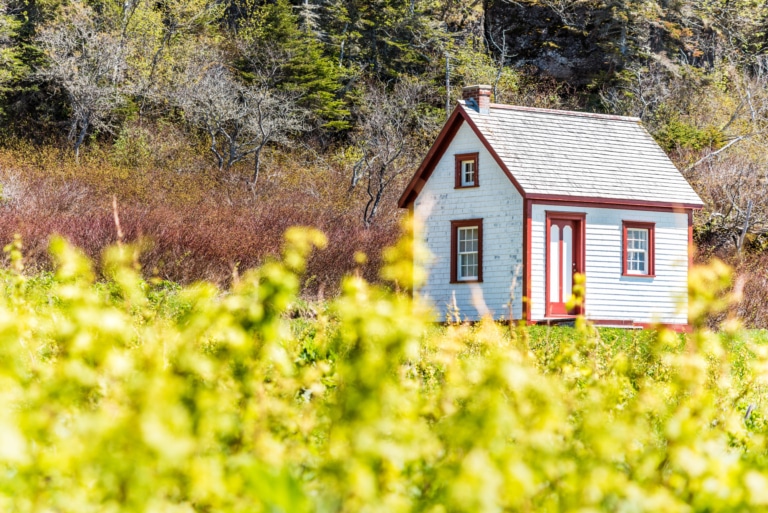Why Build a Mother-in-Law Suite for Your In-Laws?
Article updated on May 16, 2023
Keeping Your Family Close With a Mother-in-Law Suite
These days, there’s no such thing as an average household. And the truth is, that’s okay–it’s an opportunity for your family to come together. In times of crisis, whether you’re staring down the rising cost of living in California or trying to care for an aging parent, the best thing you can do is find support and solace in your loved ones.
With a mother-in-law suite, a.k.a. MIL suite, you can keep your family even closer, offering the support your parents need and the ease of access that you never had before. If you’re thinking of building a mother-in-law suite, here’s what you need to know before you kick off the project.
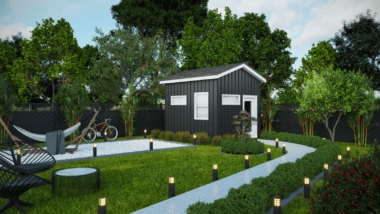
What is a Mother-in-Law Suite?
The mother-in-law suite definition is “an additional living space within your property or home designed for use by your in-laws”. Put another way, it’s an additional, fully functional living space added onto a single family home.
Many homeowners are now turning to mother-in-law suites as the perfect solution for those who want a bit of extra space to support their parents during difficult times.
After all, when the going gets tough, the best thing you can do is keep your family together.
Other Names
Chances are, if you live in California, you’ve heard of mother-in-law suites before, though you may not have heard them referenced by that name.
They’re more commonly referred to (on this site and in much literature on the subject) as accessory dwelling units, or ADUs, which is their legal and regulatory name. You may have also heard of them under other names, including:
- Accessory apartment
- Basement apartment
- Ancillary unit
- Backyard cottage
- Backyard apartment
- Carriage house
- Garage apartment
- Garden cottage
- Granny flat
- Home-within-a-home
- Junior accessory dwelling unit
- Laneway house
- Mother-daughter home
- Multigenerational home
- Secondary unit
All of these names refer to the same thing: a secondary living unit within a single family property. This is not to be confused with a guest room, and while tiny houses can sometimes be ADUs, they don’t always qualify.
That’s because mother-in-law units must be permanent, fully functional living spaces, complete with a bathroom, kitchen, sleeping area, plumbing, and foundations (which is why most tiny houses don’t qualify).
However, while the unit itself is fully functional and independent, it cannot be treated as its own independent property. It is instead part of the original single-family lot that it was built onto, and must be sold with that property.
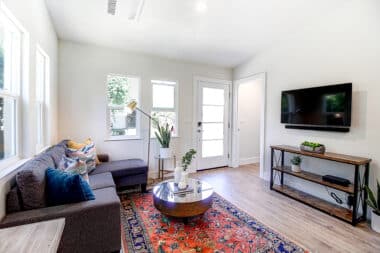
You’ll Improve the Quality of Life for Older Family Members
Many older adults would prefer to not move into a retirement home or active seniors community. They’d prefer to age in place, at least for the time being.
With that in mind, aging in place isn’t always safe if the senior stays in their own home, especially if the home is far away from friends or family members. Many seniors experience injuries when they’re at home alone, and isolation is a large problem amongst senior citizens.
So, how can you honor your loved one’s desire to age independently without letting them put themselves at risk? Yes, you could move closer to your aging loved one, but that can be difficult. So there is often a better option.
You could move them home with you. This is a good option, but both you and your family members may not love the idea of living in such close quarters. Everyone will have to make lifestyle adjustments and it’s not uncommon for people to experience “power struggles” or conflict when aging parents move in with their adult children.
An in-law suite is the perfect solution. Your loved one will get their own private home to do with as they please and you get to stay nearby to check on them if necessary. Everyone gets to maintain their privacy and their lifestyle. There are many great designs, layouts and mother in law suite ideas.
Who Could Live in an In-Law Apartment?
Though the name suggests that older adults are the ones that live in these backyard homes, they’re not the only potential residents. As previously stated, anyone can live in these homes.
These are great options for older or adult children who cannot afford their own place but want independence. They will have a fully functioning home while they save up money for their own apartment or home.
You may also choose to downsize your own life and live in the backyard property yourself. Then you could allow your adult children to live in the main home.
Granny flats or ADUs are versatile and flexible. These structures can be whatever you need them to be for your current situation.
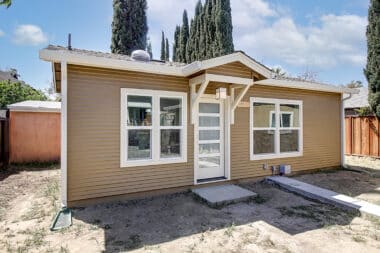
Types of Mother-in-Law Suites
Whatever name you call them, there are four types of mother-in-law (MIL) suites:
- Detached
- Attached
- Interior
- Garage conversion
Detached units are the most independent, and the most valuable ADU investment, and also the ones that Acton ADU specializes in. These are freestanding homes with their own plumbing lines and utility hookups, often with their own entrance. Another person could live a completely independent life, almost as if they were living in a separate house.
An attached unit is a bit closer to the family, in that the unit shares a wall with the primary residence. It still has its own foundations and utility hookups, and there is no internal entrance from the main house into the unit.
Interior units are the most integrated into the original home. These are often basement or attic apartments–fully functional living spaces that a casual observer would not notice from the street. Nonetheless, this is not a guest room. It is a complete apartment in every sense of the word, with everything the resident would need to function independently.
A garage conversion can be any of the previous three types, but as before, it must be a fully functional living space.
Benefits of a Mother-in-Law Apartment
So, why would you want to build a mother-in-law apartment? In times like these, between an uncertain economy, the California housing crisis, and global health concerns, now is the time to keep your family close to home.
More Hands on Deck
One of the primary benefits of multigenerational living is that there are more hands on deck when it comes to navigating life, raising children and taking care of each other. For example, if both parents work full-time, grandparents can help with things like homework, carpooling, and cooking dinner. Or if one parent is deployed in the armed services or away on frequent business trips, other family members can step in to fill the role.
Additionally, multigenerational homes provide a sense of security and stability for children. Having grandparents or other relatives nearby can provide a welcome source of support and guidance, especially during their formative years of growing up. Trustworthy family caretakers help drastically reduce the stress that is involved with day-to-day child care.
Putting Family First
The foremost benefit of a house with a MIL suite is simple: putting your family first.
The California housing crisis has hit everyone hard, but for older people, the situation is especially dire. With limited income and a narrower span of time to make up the money they need, many seniors fear eviction, homelessness, and isolation in the face of rents they simply cannot afford.
With so much fear in people’s minds, this is the time when you need your family to take care of you–especially if you’re an older person hit hard by difficult times. And if you’re an adult watching your parents struggle, it’s hard to watch the situation unfold without wanting to do something to help.
In-law quarters allow you to provide the safety net your parents need. It’s an increasingly common trend–64 million Americans aged 55 to 64, roughly 24% of that population group, now live in multigenerational housing with their loved ones, and 21% of those aged 65 and older are in similar situations.
Personal Touch
More than that, mother-in-law quarters offer you the opportunity to provide housing with a family touch.
You could help your parents try to find a home on their own, but with housing prices so high, they may need to be several hours away before they can find something within the constraints of their budget. And if they needed your help, getting to them would be an undertaking.
With a mother-in-law suite, you can offer them a housing option that works for them. They can find something closer to family, and you get to keep everyone closer together, it’s a win-win for everyone.
A Richer Family Life
In today’s fast-paced world, finding time to spend with extended family members can be hard. But when you live in close proximity to them, it’s easier to schedule regular family dinners or game nights. Grandparents can also play a more active role in their grandchildren’s lives, which can benefit both generations.
Research has shown that grandkids who spend time with their grandparents have better social skills and academic performance. And grandparents who are involved in their grandchildren’s lives tend to live longer and stay healthier overall.
Better Mental and Physical Health
Multigenerational living can help to improve the mental and physical health of your family members. Studies have shown that older adults who live with their adult children or grandchildren tend to be happier and healthier than those who live alone. They also tend to have lower rates of depression and anxiety.
If you’re considering a mother in law suite, or MIL suite for short, there are many things to take into account. But overall, there are so many great benefits to this type of arrangement. If you have the space and the desire to open your home to family members, it could be a rewarding experience for everyone involved.
Care Close to Home
If your parents or in-laws are in need of additional support as they get older, mother-in-law house offer you the opportunity to be the care and support they need.
If housing in California is expensive, supported living isn’t much better. The national median hovers around $4,000 per month (more in the San Francisco Bay Area), and if you’re like most families, you don’t have a spare $4,000 on hand to spend every month even if your in-laws need the extra care.
You could try a nursing home, but for an aging parent who just needs support and not medical care, this can be especially dispiriting. After all, they’ve lived independently for decades, and it’s difficult for many people to adjust to changing support needs after being independent for so long. It’s even worse if they know they don’t need as much support as they’re getting.
Of course, as an adult with your own children, pets, job, responsibilities, and all-around busy life, taking care of your parents in their own home may not be on the table either. You just can’t find the extra time to dart to their house every day, especially if they live further away.
A mother-in-law house is a solution that works for everyone. Now, your parents or in-laws are just a backyard away, easily accessible anytime they need support.
Versatility
The joy of mother-in-law suites is that they also open up a whole new window of opportunities for families to find a housing solution that works for them.
With housing demand astronomically high, the reality is that many seniors may not be able to find the kind of housing they actually need. And if they can find a place that fits their budget, it may require extensive remodeling to be accessible.
When you build your own mother-in-law suite, you can create a unit that’s designed to work for your parents for many years to come, a unit that will meet their needs even if their mobility starts to decline or they have additional needs. You can create a unit that fits exactly what your parents need, no matter what those needs are.
Convenience
Plus, there’s something to be said for the convenience of mother-in-law suites–for everyone involved.
With your parents or in-laws in a mother-in-law suite, both sides have access they never would have had otherwise. You can dart across the backyard to take care of your parents, and your parents, too, can come to the house to help out with dinner, sit with the kids to do homework, run an errand, or just keep you company.
It’s a chance for your family to spend time together in ways that never would have been possible before, a bonding opportunity that joins everyone.
Added Comfort During the Holidays
Even if your parents or in-laws don’t take up full residence in the mother-in-law suite, they can still make use of the unit when they do come to visit.
It doesn’t matter how close you are with your parents or in-laws–when you get two distinct family units that are used to functioning separately, there are going to be a few kinks to iron out. They’re used to being independent, you’re used to being independent, and you’re both used to being independent on a different schedule.
Mother-in-law suites allow you just enough space during holidays to enjoy each other’s company and have a bit of breathing space at the end of the night. You can disengage if you need some space or jump right into the middle of the hubbub–either way, you’ll have the comfort of keeping your own routines without disturbing each other.
Added Support
Last but not least, building a mother-in-law suite is a great chance to get extra support for your parents and for your own family.
If you have kids and your parents or in-laws live farther away, both sides would love to spend more time together, even though the distance keeps getting in the way. Mother-in-law suites allow your family to do what family does best: support each other.
Your parents or in-laws get to spend more time with the grandkids, and you get another person to help out when you need it. It’s a win-win scenario for everyone involved, and it still gives you a sustainable housing option for years to come, no matter what your needs look like in the future.
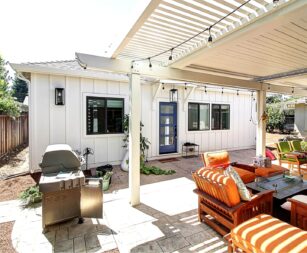
Building a Mother-in-Law Suite
Is a mother-in-law suite the right fit for you? Chances are, if your parents or in-laws need extra support, it may just be the answer you’ve been looking for.
However, you should know what you’re signing up for. Here are a few factors to keep in mind before building a mother-in-law suite for your in-laws.
Get Approved Early
With any major home improvement, you want to start as early as possible. But the process of building an accessory dwelling unit on your property is a lot more complicated than a kitchen remodel.
So if you have a deadline of when your in-laws are going to move in, plan to start months before then.
You’ll have to get your project validated, understand your budget, secure financing, and get approval to start the building. For example, dealing with plumbing and sewage lines, or in some cases, septic can be an arduous process in itself. Not to mention structural engineering or energy requirements. Building an ADU isn’t always easy.
Before you break ground, make sure all of your paperwork and plans have been assessed by professionals.
Look for Good Contractors
You might be good with a hammer and screwdriver, but you’re going to want to leave the building to professionals. Though smaller, these apartments are fully functioning homes.
This means there are electricity, water, and structural integrity standards that must be met for it to be a proper and safe home.
Many contractors could help you with your project. But one that specializes in building backyard homes or accessory dwelling units is the better option.
ADU specialists know the required regulations to create an ADU in your backyard. Their specialization means they know exactly what needs to be done and can meet your requests.
When searching for contractors, ask if they have proven experience with successful in-law apartment construction. Look at their previous work and explain your project. Together you decide if it’s a good match to move forward.
The Cost
With housing prices as steep as they are, the cost of building a mother-in-law suite is a significant consideration, especially for a middle class family.
First, it’s important to understand that mother-in-law suites are more expensive per square foot than a regular single family house, though there are several reasons why that is. For one thing, there are fixed costs associated with permitting and fees, and you’ll have to pay for a new foundation, utility hookups, plumbing, etc.
Plus, while the square footage of a mother-in-law suite is significantly smaller than the average single family home, keep in mind that a significant part of the square footage is expensive square footage–kitchen and bathroom. Plus, because there are no extra bedrooms and hallways, the cost per square footage isn’t offset by extra rooms and averages.
That said, you are packing a lot more value into a much smaller space.
So, how much does it cost to build a mother-in-law suite? That depends on the suite.
As with any other construction, the more complicated the project, the more expensive it will be to build. Builds require pouring a new foundation and getting new plumbing hookups, not to mention site specific requirements, size, materials, or any specific fees required for your lot.
However, you can significantly offset the costs with shortcuts offered in your area. In San Jose, for example, there are pre-approved master plans which significantly lower the cost of design and speed up permitting and approvals.
Choosing the Right Building Option
Keep in mind, however, that not all price options will be within your control.
Detached and attached units have limitations. You have to position a unit in the right place, which means working with your contractor to figure out where a new unit might be positioned in relation to your existing home. They can also help you determine what options are workable for your current budget.
If you’re going to have your parents or in-laws moving directly into the suite, it may be a good idea to get their input with the contractor. This will help ensure you end up with a suite that makes everyone happy (and meets their needs as well as your building constraints).
The Building Process
Once you know what kind of backyard apartment is the right fit for you, the building process is relatively straightforward. You just have to know what you’re doing, how to allocate your resources, and how to simplify the process.
One of the best things you can do before you begin building is to get organized. Here’s a quick guide to essential issues you’ll need to address before the building process can begin in earnest.
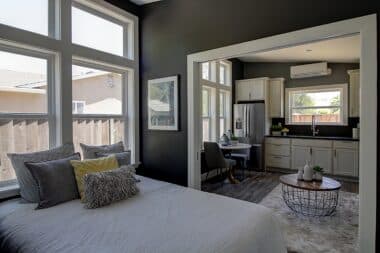
Where You Can Build an ADU
The first question is knowing where you can build an ADU, which, as we’ve noted, is a bit more complicated than it sounds.
The big issue is zoning–you have to know whether or not your property is zoned in a way that qualifies for granny flat construction.
According to San Jose’s Universal ADU Checklist, the first thing to ask is whether your property is in a residential zone beginning with R-1, R-2, R-M, or PD. Or, regardless of zoning, your property must meet one of the following General Plan designations:
- Residential neighborhood, mixed use neighborhood, or mixed-use commercial
- Urban residential, transit residential, or rural residential
- Downtown or urban village
If any of the above is a no, your property cannot have a cottage ADU.
If yes and you have a single family property, your property may have one ADU (subject to standards).
If yes and you have a duplex or multifamily property, two detached ADUs may be allowed. Duplexes may be allowed with one attached ADU. Multifamily units may have a number of attached ADUs equal to 25% of existing units.
Keep an eye on current ADU ordinances for the most recent updates to ADU rules and regulations in San Jose. Your contractor can also help you make sense of ADU regulations as they apply to your property.
Fire Requirements
One of the important areas to watch is fire requirements. You can find all of this information in the San Jose Universal Checklist, but we’ll do a quick review of the key points.
Your suite plans will be reviewed for compliance with the California Fire Code. San Jose will ask six questions:
- Is the primary residence protected by fire sprinklers? If yes, the cottage ADU must also have fire sprinklers.
- Is the project an attached ADU greater than 500 feet AND does the overall gross floor area of the main unit exceed 3,600 square feet? If yes, the ADU and main unit must be protected by fire sprinklers.
- Is the address of the ADU visible from the street? If not, your project may require a Fire Variance with additional safety measures.
- Is the distance from the street curb of the lot to all portions of the proposed ADU no greater than 200 feet as measured along a minimum 3-foot clear path to all sides of the ADU? If not, your project may require a Fire Variance with additional safety measures.
- Are all exterior walls of the ADU within 600 feet of a fire hydrant? If not, your project may require a Fire Variance with additional safety measures.
- Is a minimum flow of 1,000 gpm at 20 psi available from the closest hydrant? You are required to submit a letter from your water company detailing water flow data when you submit your building permit application.
If any of these requirements are not met, or neglected in your application, your application will not be approved.
Parking Requirements
Last but not least are parking requirements.
As a rule, in San Jose, one parking space is required unless the property qualifies for an exemption. Units that meet any of the following criteria are exempt:
- The unit is located in a historic district listed in San Jose’s Historic Resources Inventory
- The unit is part of or within the primary residence (such as a basement apartment)
The unit is located within .5 miles of a bus or rail station AND the path of travel is publicly accessible
The unit is on a street that requires on-street parking permits, but the permit has not been offered to the occupant of the accessory unit
The unit is located within one block of an area where a motor vehicle provides daily or hourly services as part of a regional fleet run by a public agency or publicly-leased motor-sharing organization
Otherwise, your property is required to have one parking space. If your construction eliminates that parking (for example, if you convert your garage) you will have to replace that parking in some other way.
Having Your Own Space
A small-scale cottage home in your backyard isn’t difficult to maintain, and with your mother-in-law living there, you can really reap the benefits of having a beautiful cottage ADU in your backyard. Giving her her own space in the yard would be a good idea, so she can feel like she’s part of the family and the property in her later years.
If you’re looking into getting or setting up a mother-in-law cottage, then you’re in luck. Acton ADU is an accessory dwelling unit construction company, and we’re here to help you. We make building a mother-in-law cottage on your property as easy as possible. We’re well versed in the zoning laws in your area, and we can let you know what you can and can’t do with an ADU based on where you live. We then would be able to build your mother-in-law’s cottage for you from scratch in a timely manner.
Ready to Build Your Mother-in-Law Suite?
We know that while a tiny house is a small space, it’s no small undertaking for you and your loved ones. After all, you’re navigating city and state laws to build a home that will support your loved ones for years to come. To do that, you need builders who are ready to support you.
That’s where we at Acton ADU come in.
We’re ADU experts, specializing in designing, navigating, and building personalized mother-in-law suites. More importantly, we’ve served families just like yours for over 30 years–we know what it takes to create a unit you love, and we’re ready to make it happen.
Let’s make your housing dream a reality. Get in touch today to start the conversation about building an ADU in the Bay Area, CA.
Schedule a free consultation today!





